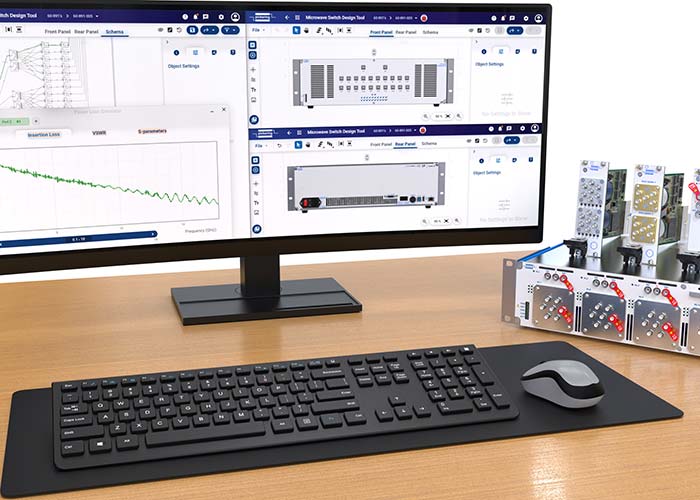 Pickering Interfaces, the leading supplier of modular signal switching and simulation solutions for use in electronic test and verification, announced today that its Microwave Switch Design Tool – a free online tool for configuring application-specific PXI and LXI RF & microwave switching subsystems with just a few clicks – has been updated to include schematic design and simulation capabilities. Debuting at EuMW (European Microwave Week) 2024, the latest iteration of this web-based tool accelerates the design to production process – from block diagram to mechanical layout – and minimizes risk by enabling you to design your own custom RF switching subsystem with an immediate visual indication of electrical performance.
Pickering Interfaces, the leading supplier of modular signal switching and simulation solutions for use in electronic test and verification, announced today that its Microwave Switch Design Tool – a free online tool for configuring application-specific PXI and LXI RF & microwave switching subsystems with just a few clicks – has been updated to include schematic design and simulation capabilities. Debuting at EuMW (European Microwave Week) 2024, the latest iteration of this web-based tool accelerates the design to production process – from block diagram to mechanical layout – and minimizes risk by enabling you to design your own custom RF switching subsystem with an immediate visual indication of electrical performance.
The new schematic and simulation tools seamlessly integrate with the existing panel configurator within Microwave Switch Design Tool (MSDT), allowing you to go directly from an electrical schematic diagram, with verified RF performance, to a mechanical layout (front and/or rear panels). In this way, MSDT functions as a powerful extension to your engineering team, allowing them to easily collaborate with Pickering’s team of RF engineers. MSDT simplifies the creation of custom and turnkey RF & microwave switching and relay subsystems for signal routing applications across the aerospace and defense, wireless communications, automotive, medical, and semiconductor industries.
“We have updated our Microwave Switch Design Tool web-based application to add circuit schematic generation and RF circuit simulation,” explains Simon Aylott, Microwave Division Manager at Pickering Interfaces. “These enhancements allow engineers to graphically design and verify their RF switching subsystem on a virtual PXI or LXI platform. You can rapidly create circuit diagrams and accurately simulate the electrical performance of your design, giving you an immediate visual indication of the system’s predicted RF performance. You can then refine and optimize the design before committing to the system build process. This flexibility saves significant time and resources – and minimizes the risks associated with complex RFIU switching system design projects.”
Available free and online, with no installation required, MSDT’s web-based graphical toolset minimizes risk by offering intuitive design, test and optimization of complex RF and microwave switching systems in a virtual environment before physical models are built. With access to a large range of RF and microwave components, the tool supports electrical design via the generation of schematic diagrams, including interconnect cabling and circuit simulation of individual components and the full signal path, as well as mechanical design through the creation of front and/or rear panels. Accurate prediction of RF electrical performance improves confidence, thereby reducing the risks associated with complex product design. The range of components offered in MSDT is continually evolving, and alternate items can be requested for inclusion in the component database.
MSDT is part of Pickering’s growing online design toolset, which helps test engineers graphically design, share, maintain, and visualize various parts of test system architecture. Data reusability and integration with Pickering’s software and simulation tools increase development efficiency by reducing redundant manual tasks and associated errors.
For more than 35 years, test engineers have relied on Pickering Interfaces to help accelerate their project development cycle and streamline production readiness when building competitively priced, industry standard, high-performance modular microwave switching systems, providing the foundation for highly reconfigurable signal routing solutions. The updated Microwave Switch Design Tool simplifies and accelerates this process.



